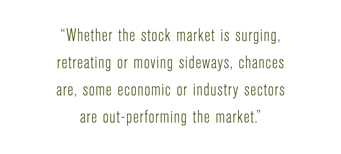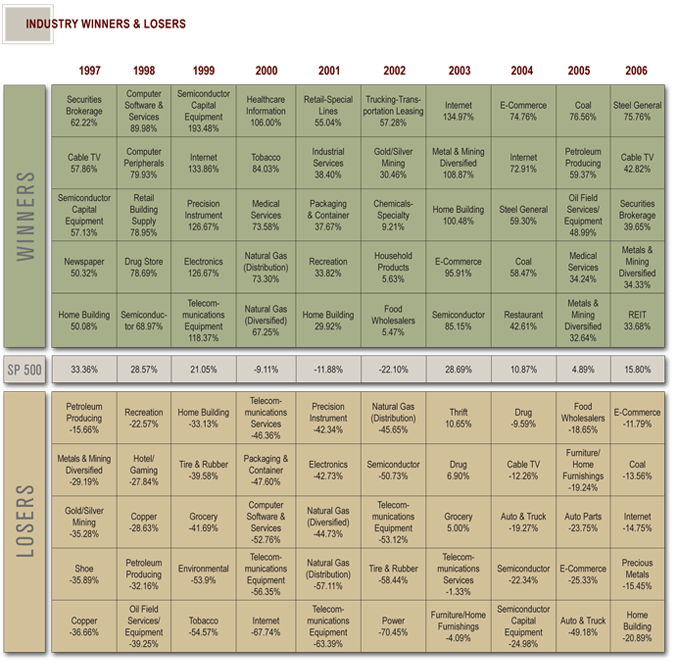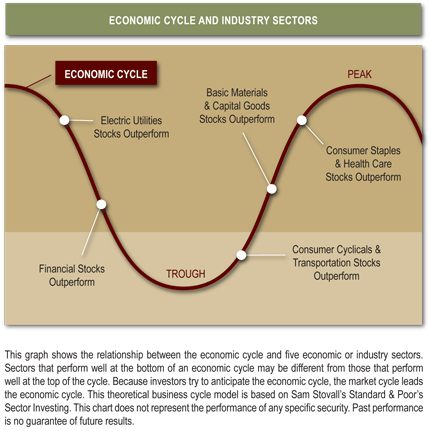|
|
 |
 |
|
|
Economic sectors and industries often have distinct
cycles. As a result, last year’s stock market laggards
may become this year’s stock market leaders. For
some industries, stock market performance may be
closely linked to the business cycle. Other industries
may respond, favorably or unfavorably, to changes in
interest rates, currency exchange rates, government
policy, technology, consumer spending, capital
spending, competitive environment, or commodity
prices.
Because industries are affected by a variety of factors
from competitive environment to regulatory issues,
their performance can vary dramatically. The chart on
page 3 shows the range of total annual returns from |
 |
1997 to 2006 for the five highest performing and five
lowest performing industry sectors. Over the ten year
period, the top five industries produced an average
annual return of 64.5%. In contrast, the Standard
and Poor’s 500 generated an average annual return
of 8.4%, and the bottom five industries generated an
average annual return of -34.8%. We believe the wide
disparity of returns creates a tremendous and ongoing
investment opportunity.
By systematically rotating among a variety of industries,
we seek to take advantage of certain industry sectors’
relative out-performance at different points in the
economic and market cycle.
|
|
 |
 |
DISCLAIMER:
Performance shown is past and cannot guarantee comparable future results. The performance figures are historical, reflect price appreciation only, and cannot guarantee comparable future results. This chart is for illustrative purposes and does not reflect
the performance of any investment account. The table depicts annual returns, price appreciation only, for the top five highest performing and five lowest performing industry sectors over the past 10 years, ranked from best to worst. All sector indices are
based upon the S&P 500. The S&P 500 index is an unmanaged index considered representative of the U.S. stock market. From January 1997 through February 2002, S&P’s indices were divided into 11 economic sectors and 118 industry groups. From
March 2002, the indices are based on Standard and Poor’s and Morgan Stanley Capital International Global Industry Classification System (GICS). The GICS consists of approximately 10 economic sectors, 23 industry groups, 59 industries and 123 subindustries.
All indices are unmanaged industry sector indexes. An investment cannot be made directly in an index. |
 |
|
market and industry influences, with the remaining 40%
dependent on company specific factors.
Sector Logic seeks to enhance portfolio returns through
its proprietary methodology. First, by identifying
industries with superior business momentum, including
acceleration in earnings growth, we improve the
likelihood that we will identify industries that will benefit
from upcoming economic developments. Second,
by identifying industries with superior stock price
performance, we seek to benefit from current market
trends.
|
Sector Logic’s quantitatively driven sector rotation
strategy reflects our core belief that companies with
positive business momentum, including strong and
accelerating earnings growth, improving profitability
and attractive valuations represent superior investment
opportunities.
We analyze, evaluate, and rank approximately
100 industries on a weekly basis in order of potential
for out-performance. Sector Logic’s methodology
is designed to identify industry sectors with the
greatest 3-12 month price appreciation potential. Our
disciplined ranking process identifies industries with
higher potential for superior returns.
Sector Logic takes a totally unique approach to industry
sector rotation. We evaluate industry sectors based on
company and industry fundamentals, and current market
trends. By analyzing the underlying fundamentals of
the stocks, which comprise the industries, we seek to
identify industries that are likely to be top performers
for a sustained period of time. By incorporating relative
strength into our methodology, we select holdings that
are out-performing alternatives. We regularly rotate
portfolio holdings as new leaders emerge in response
to changes in market and economic conditions.
We believe sector investing can be rewarding. The
keys are to limit risk and adhere to a strict discipline. |
 |
 |
 |
There is an old saying on Wall Street, “A rising tide lifts
all boats”. In other words, if a particular industry is “hot”,
all stocks within that industry will likely benefit. Studies
have shown that as much as 60% of the price fluctuation
of an individual stock can be identified by economic, |
Sector Logic takes sector rotation to the next level.
To harness the full potential of sector investing, we
seek to invest in the right industry sectors at the right
time. More importantly for reducing risk, we seek to
avoid industry sectors that have a higher probability of
poor performance. Our systematic method effectively
reduces the investment risk associated with emotional
biases that adversely affect decision-making. |
|
|
|
|










